
Microsoft kicked off its BUILD developer conference in San Francisco today, with a keynote address led by CEO Steve Ballmer. He was typically upbeat and enthusiastic about the company and what lies ahead over the next couple of days, and the opportunities that Microsoft is building for its huge community of developers across the world, many of whom travelled vast distances, and paid considerable sums, for the privilege of attending BUILD.
Ballmer was joined on stage by other key members of the Microsoft team, who together explained what the company is doing to transform itself with the help of increasingly advanced software running on what it believes to be a class-leading development platform.

Ballmer began the keynote by expressing his great pleasure to be welcoming back delegates to BUILD so soon after last year's event. He said that it was a testament to the rapid pace of innovation in the industry, and also to Microsoft's ability to adapt more easily and more readily to the changes that the industry is facing.
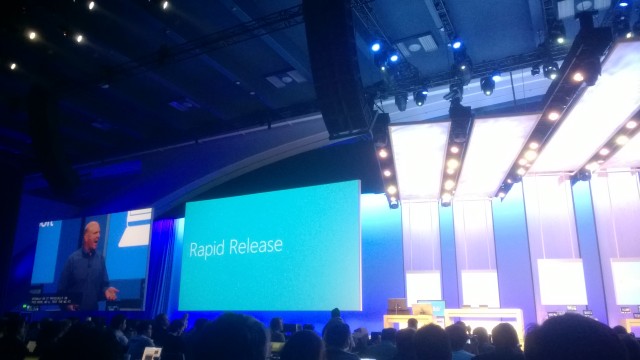
"Rapid release, rapid release, rapid release" was the mantra that he chanted, and which he frequently referenced in his remarks. He reiterated that Microsoft is in the midst of a complete transformation as a company, one led by "software-powered devices and software-powered services", and that the only way to drive this change is through a principle of rapid release of software and updates that improve it over time. Underlining this point further, Ballmer said that this "rapid release cadence is the new norm at Microsoft... it's fundamental to what we're doing".
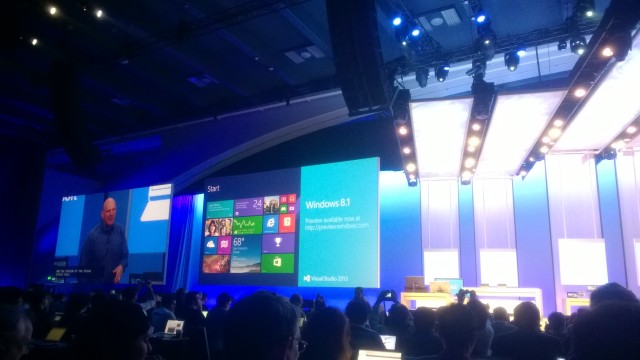
This allowed him to neatly segue into announcing the availability of the Public Preview of Windows 8.1, available free to download today. Unsurprisingly, he encouraged everyone to download it immediately - although it's worth bearing in mind that not all Windows 8 devices will be able to run the Windows 8.1 preview version.

Next, he spoke passionately about Windows Phone and the new hardware that's come to market recently, through devices such as the Nokia Lumia 925, and Sprint's recent confirmation that it will finally start selling Windows Phone 8 handsets.

With the focus of the event firmly on Windows 8, rather than Windows Phone 8, Ballmer quickly moved on to talk about the new PCs, tablets and hybrids that have launched on the platform in recent months. A particular focus was the Acer Iconia W3, as Windows 8.1 brings enhancements to support smaller devices. He referred to these, and other non-traditional form factors, as "transformational devices", adding that their availability is part of a broader "Windows device transformation".

To the delight of all attendees, he then announced that everyone attending BUILD would get a free Acer Iconia W3, before elaborating further on the offering that such smaller devices bring to the table. He emphasised that they offer the same functionality as other Windows 8 devices, including the same apps, the ability to run Desktop applications, and full PC-like capability - although he added that he "wouldn't call them PCs".
Ballmer noted that in the lead-up to Windows 8 - and particularly at last year's BUILD conference - there was one major focus in both the marketing and the developer side of things: "Touch, touch, touch, touch, touch". But, he continued, "when we launched Windows 8, many of the devices didn't even have touch!" Now, Ballmer said that touch is "transforming devices", and is an "incredibly valuable" feature in even traditional PC form factors. While he didn't share actual statistics, he claimed that Microsoft research had found that Windows 8 users with touch are "much happier" than those without touch, and much happier than Windows 7 users too.
He then went on to show off other Windows 8 devices, including the Lenovo ThinkPad Helix, which he almost dropped when placing it back on the rostrum towards the back of the stage. "Shall we call it a PC?" he said. "Shall we call it a tablet? I call it 'all Windows, all the time'".

He then moved on to discuss apps on the platform, beginning with the announcement that Facebook and Flipboard apps will soon be launching on Windows 8. "We pushed boldly with the Modern app experience," he said, but he implicitly acknowledged that this had perhaps come at the expense of the Desktop.

Feedback from users and developers had indicated a desire to adjust the balance of the Desktop versus the Modern user experience; Ballmer said that with Windows 8.1, Microsoft has "refined the blend" of the Desktop/Modern dichotomy. Referencing the return of the Start button drew huge applause from the crowd, and similarly enthusiastic responses to the new ability to boot directly to the desktop.
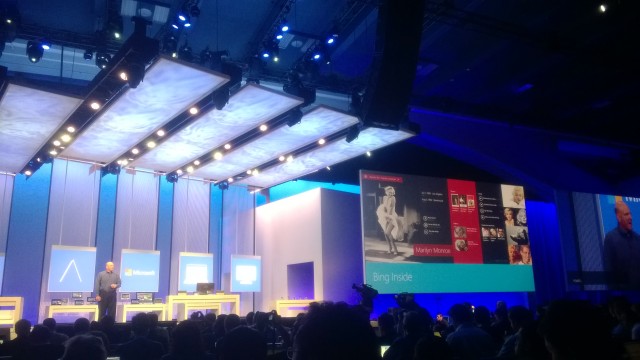
He next moved on to Bing, saying that Microsoft's engineers and developers have "built an incredible product", and one that is now being more extensively harnessed to improve and expand on the fundamental abilities of Windows 8. With Windows 8.1, "our shell experience is powered by Bing", he said. "We're opening up Bing as an app development platform... to help build that richness [of search] into your apps running on top of Windows." The new buzz phrase here is "Bing inside".

Ballmer introduced Julie Larson-Green, head of the Windows team, who took over from Steven Sinofsky after his departure. She spoke at breakneck speed about the vast improvements that Microsoft's development teams have made with the Windows 8 OS; she said that there have been over 800 improvements to the OS since it launched in October last year.
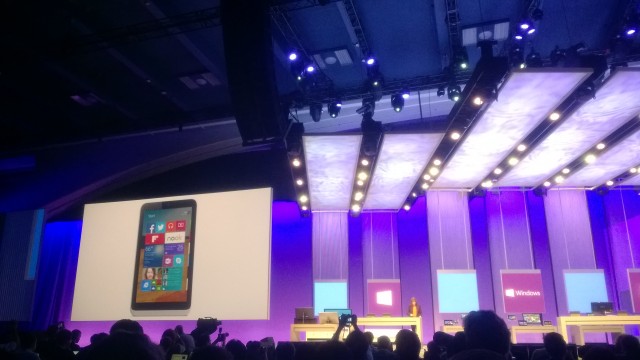
Next, she showed the enhancements that have been made to the OS for smaller form-factor devices such as the Iconia W3, including better Start screen support in portrait mode, and the addition of gestures to the on-screen keyboard to make typing easier while holding the device upright and typing with your thumbs.
Search has been dramatically enhanced in Windows 8.1; she described the Search Charm as "the modern command line to your system", calling it "the one way to get to everything you want to do".
Searching for things is "like [using] an app that's been built on the fly", she said. Searching offers a comprehensive multimedia breakdown of content options, part of the Bing platform's algorithms to 'predict user intent' to help users complete tasks rather than just direct them to content on third party websites, which creates a disconnect between the search and the result.
Search for a destination, and you'll get a rich and beautiful interface showcasing content such as weather (which will jump you to the Bing Weather app if you want to find out more), maps (opens Bing Maps), restaurant reservations (automatically opens the appropriate app on your system), and plenty more besides these examples. Larson-Green said that "search is not just a list of links, it's things that you can do".

The Xbox Music app has been completely redesigned with an improved focus on playing and enjoying content, whereas the previous version was focused more upon content discovery. New functionality has been baked into the platform too, harnessing the improved Bing integration. She showed a "regular music web page" and, using the Windows 8.1 Search Charm, she was able to automatically comb the website to find a list of songs, which created a playlist that she could listen to in Xbox Music. That got a big round of applause.

The enhanced Start screen experience brings the aforementioned return of the Start button to the Desktop. When the Start button is pressed, the Live Tiles of the Start Screen can simply hover over your existing Desktop background. Pivot left-to-right to view pinned tiles, just like today.

Swipe up to reveal the 'All Apps' view. Larson-Green said that with this view, you can view "four times more apps on the screen than you ever could with the old-style Start menu".
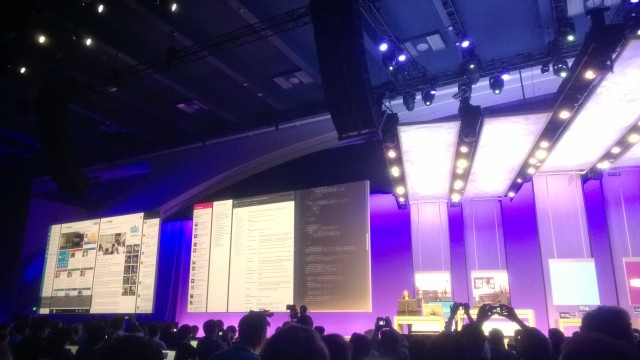
There's also improved support for multi-monitor set-ups and split-screen views. The 'Snap View' is no longer restricted to the one-third/two-thirds view which allowed only two apps to be viewed side-by-side; in the image above, you can see eight apps running across two displays, with varying widths in each app to suit user requirements and tastes.

We also got a quick preview of a new Modern-style version of PowerPoint. While a version of PowerPoint 2013 already exists for Windows RT, this - like other Office RT apps - is a simple port of its non-ARM equivalent.

She said that the version that she briefly showed off was a very early 'alpha' preview of a version of PowerPoint designed with the Modern UI. No word yet on when that will see the light of day, although there have been some rumblings that it could arrive next year.
Julie Larson-Green ended her time on stage by stating that "Windows 8.1 is Windows 8, refined", which sounds like a pretty succinct and accurate way to sum things up.

Antoine Leblond took to the stage next to talk about the developer opportunities in Windows 8.1. He said that the new OS brings a wealth of new APIs, and Visual Studio 2013 is the key to harnessing these opportunities for developers. He confirmed that a preview version of VS2013 has been made available today, and highlighted a couple of examples of the capabilities that the latest version has added.
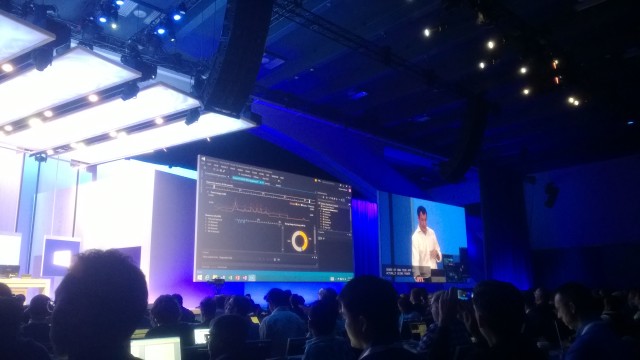
One rather nifty new feature is the power consumption analysis tool, which can gauge how power-efficient your app is, and can even give you some idea of how long the app would be able to run on a device before the battery dies. Lovely.
There's also a new wizard to help developers to easily add push notification capabilities to their apps; Leblond demonstrated how simple it makes the process of adding this feature, with Windows Azure cloud support, right from inside the app, making it incredibly simple to set up push events that display alerts on Live Tiles right on your Start Screen.

Leblond said that the Windows Store offers the "best economics of any app store out there, period", and Microsoft has introduced a dramatic overhaul of the Store based around the principles of "better merchandising, better economics, easier to sell". Because "people love lists" when discovering new apps, there are loads more lists to showcase apps in various categories, including the "Picks for you" feature, which uses your previous purchases and Bing history to offer up suggestions for apps that you might like.

There are also larger, higher-resolution screenshots, along with rich ratings and improved review features, as well as better cross-promotion for related apps, and apps created by the same developer. Coupled with improved navigation throughout the Store, Leblond says that this is all designed not only to help users, but also to help developers in making it easier to sell their apps and make more money.

Leblond said that Microsoft "continues to innovate to make Windows the best platform for both casual and AAA games, and the introduction of 'tiled resources' brings support for incredible improvements to graphics on the platform. Indeed, so great are these improvements that Leblond said "you can't even dream of doing this stuff on iOS or Android", stating that to get such a level of graphics performance on devices, you'll either need a Windows 8.1 device or a next-generation console like the Xbox One.
The image above doesn't do justice to the quality of the graphics actually shown on screen; as Leblond himself pointed out, individual rivets on the plane could be seen, along with subtle scuffs in its paintwork, while the dynamics of the sea, and the waves breaking across the coastline, were certainly impressive.

Leblond closed his time on stage by highlighting the efforts of OEMs in building what Microsoft believes to be an exceptional range of devices for Windows 8. One device that he mentioned was Samsung's ATIV Book 9 Plus, which features a 3800x1800px display and an impressive 12-hour battery life (manufacturer's claim), which drew considerable applause from the audience. However, a second device drew some less-than-impressed laughter from the crowd: Dell's 'giant tablet', the XPS 18.

Before leaving the stage, he was joined again briefly by Julie Larson-Green, who revealed that BUILD attendees would also be getting a Surface Pro, in addition to the Acer Iconia W3.
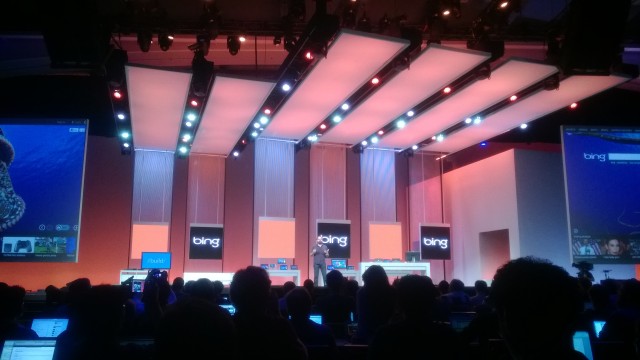
Next up was Gurdeep Singh Pall, corporate vice-president for Bing, who began by highlighting the achievements of the search engine. Calling it an "incredible product built by incredible engineers", he praised Bing's current 17.4% US market share, and added that it is continuing to gain significant traction in the market. "Facebook Bings, Yahoo Bings, Apple Siri Bings," he said.

He added that Microsoft engineers have "not only built an incredible search engine, but also incredible infrastructure", as we discovered when we got an insight into the company's efforts in developing Bing a couple of months ago. Bing "makes sense of large, unstructured content on the web... predicting user intent", not just serving up a static page of third-party links.
Bing, he added, offers "endless capabilities... but how do we harness them?" By opening up Bing as a development platform in its own right, enabling developers to harness the power of Bing's integrated multi-discipline search features to augment the abilities of the apps that they create.

Bing Maps on Windows 8.1 will feature integrated 3D imagery, with 3D control that can be fully embedded into third-party apps. The 3D imaging was built using high-resolution optics and cameras built by Microsoft itself, and offers sophisticated panoramas and zoom controls, with the ability to pan, rotate and navigate through three-dimensional cityscapes.

Zooming in on a building in Valencia, Spain, within the 3D maps view, he vocally asked Bing, "Who is the architect?" which immediately brought up a panel of introductory information, with links to further details. New APIs in Windows 8.1 enable connected and integrated content and discovery, harnessing Bing's search algorithms and technology.
Gurdeep Singh Pall ended by underlining Microsoft's goal in opening up Bing as a development platform: "A seamless experience for you as developers, to create a seamless experience for users."
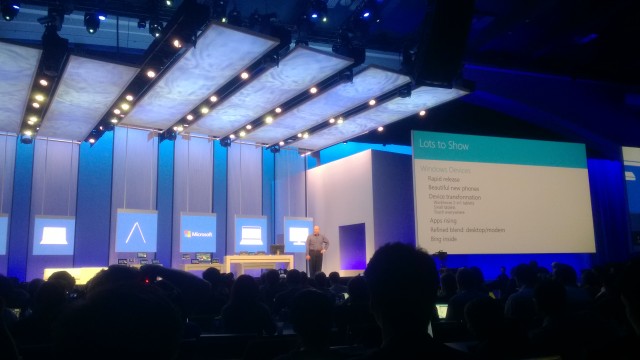
Finally, Steve Ballmer returned to the stage to wrap things up. He said that Microsoft has established a thread of "deep innovation across everything that we do". He talked up the benefits of having a unified "innovative experience on every device for everything, from work to play to serious fun".
Hundreds of millions of Windows devices will be sold, he said: "Windows tablets, Windows Phones, Windows PCs... Windows, Windows, Windows." He added that the rise of new form factors on Windows platforms is great for consumers, but also offers an "unparalleled opportunity" for developers in connecting with users in new ways, such as touch, and the ability to build modern, connected experiences has never been better.
Closing the keynote, he said: "The future of Windows is very, very bright."















9 Comments - Add comment